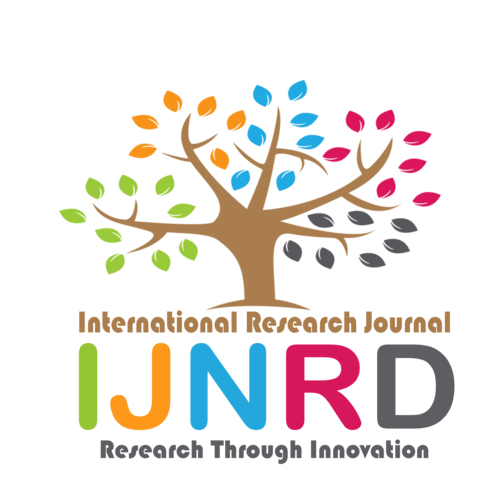|
|||||||||||||||

|
INTERNATIONAL JOURNAL OF NOVEL RESEARCH AND DEVELOPMENT International Peer Reviewed & Refereed Journals, Open Access Journal ISSN Approved Journal No: 2456-4184 | Impact factor: 8.76 | ESTD Year: 2016 Scholarly open access journals, Peer-reviewed, and Refereed Journals, Impact factor 8.76 (Calculate by google scholar and Semantic Scholar | AI-Powered Research Tool) , Multidisciplinary, Monthly, Indexing in all major database & Metadata, Citation Generator, Digital Object Identifier(DOI) |
||||||||||||||
Issue: April 2024
Volume 9 | Issue 4
Review Result and Publication of Paper within : 2-3 days
Click Here For more DetailsFor Authors
Forms / Download
Published Issue Details
Editorial Board
Other IMP Links
Facts & Figure
Impact Factor : 8.76
Issue per Year : 12
Volume Published : 9
Issue Published : 95
Article Submitted :
Article Published :
Total Authors :
Total Reviewer :
Total Countries :
Indexing Partner
Join RMS/Earn 300
Licence
This work is licensed under a Creative Commons Attribution-NonCommercial 4.0 International License







|
Published Paper Details
|
|
| Paper Title: | Toxicity analysis of aqueous waste of textile industry: Effects on human, Aquatic and Agriculture system. |
| Authors Name: | sanjana , ajit kumar , manas mathur |
| Download E-Certificate: | Download |
| Author Reg. ID: |
IJNRD_181666
|
| Published Paper Id: | IJNRD2206005 |
| Published In: | Volume 7 Issue 6, June-2022 |
| DOI: | |
| Abstract: | Humans rapidly devour environmental riches for their growth; among the resources they consume, water is being consumed at an alarming rate owing to unregulated and unsustainable usage. A massive volume of wastewater is produced across the world as a result of industrialization and domestic usage as a result of urbanization. Numerous contaminants identified in water bodies have been reported to be generated major health difficulties and studying the release mechanism, degradation process, and execution of their removal procedure before discharging into natural water bodies is required. Temperature, pH, electrical conductivity (EC), turbidity, dissolved oxygen (DO), chemical oxygen demand (COD), biochemical oxygen demand (BOD), total suspended solids (TSS), color, alkalinity, total dissolved solids (TDS), and heavy metal ions were used to characterize the substance of textile wastewater quality (cadmium, copper, forum manganese, lead, and zinc). The results also showed that several of the conditions for the ultimate discharge of textile wastewater could not be properly discharged because textile wastewater had been shown to include a high level of contaminants, including excessive TDS and suspended particles. Due to dyestuff and suspended particulates, the wastewater is intensely colored and viscous. Because of the large use of sodium salts in processing facilities, sodium is the dominant important cation. Although chloride is the most abundant anion in wastewater, bicarbonate, sulphate, and nitrate concentrations are also significant (>100 mg/L). In most cases, sodium salts of these anions are utilized in the procedure. Chromium is the most abundant toxic metal, although other toxic substances such as iron, zinc, lead, copper, and manganese are also found. The wastewater also contains high BOD and COD levels, indicating that it is polluting. Toxicity effect on human health, aquatic life, agriculture fields, and soil fertility. |
| Keywords: | Industrialization, textile wastewater, wastewater qualities, hazardous effect, natural water bodies |
| Cite Article: | "Toxicity analysis of aqueous waste of textile industry: Effects on human, Aquatic and Agriculture system.", International Journal of Novel Research and Development (www.ijnrd.org), ISSN:2456-4184, Vol.7, Issue 6, page no.31-46, June-2022, Available :http://www.ijnrd.org/papers/IJNRD2206005.pdf |
| Downloads: | 000118762 |
| ISSN: |
2456-4184 | IMPACT FACTOR: 8.76 Calculated By Google Scholar| ESTD YEAR: 2016 An International Scholarly Open Access Journal, Peer-Reviewed, Refereed Journal Impact Factor 8.76 Calculate by Google Scholar and Semantic Scholar | AI-Powered Research Tool, Multidisciplinary, Monthly, Multilanguage Journal Indexing in All Major Database & Metadata, Citation Generator |
| Publication Details: |
Published Paper ID:IJNRD2206005 Registration ID: 181666 Published In: Volume 7 Issue 6, June-2022 DOI (Digital Object Identifier): Page No: 31-46 Country: faridabad, haryana, India Research Area: Life Sciences Publisher : IJ Publication Published Paper URL : https://www.ijnrd.org/viewpaperforall?paper=IJNRD2206005 Published Paper PDF: https://www.ijnrd.org/papers/IJNRD2206005 |
| Share Article: | |
|
Click Here to Download This Article |
|
| Article Preview | |
|
|
|
Major Indexing from www.ijnrd.org
| Semantic Scholar | Microsaoft Academic | ORCID | Zenodo |
| Google Scholar | ResearcherID Thomson Reuters | Mendeley : reference manager | Academia.edu |
| arXiv.org : cornell university library | Research Gate | CiteSeerX | PUBLON |
| DRJI | SSRN | Scribd | DocStoc |
ISSN Details
 |
 |
ISSN: 2456-4184
Impact Factor: 8.76 and ISSN APPROVED
Journal Starting Year (ESTD) : 2016
DOI (A digital object identifier)
Conference
Open Access License Policy
Important Details
Social Media
| Copyright © 2024 - All Rights Reserved - IJNRD |












Facebook Twitter Instagram LinkedIn